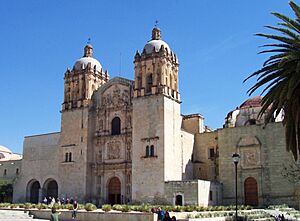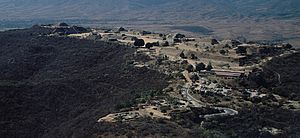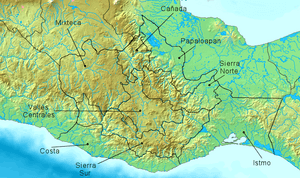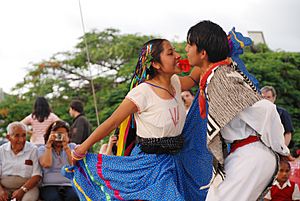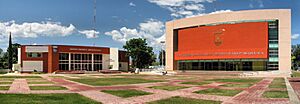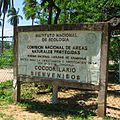Oaxaca facts for kids
Quick facts for kids
State of Oaxaca
|
|||
|---|---|---|---|
|
|||
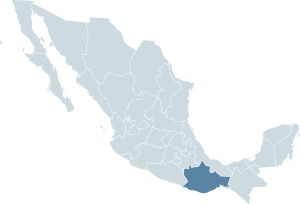
Location within Mexico
|
|||

Municipalities of Oaxaca
|
|||
| Country | |||
| Capital | Oaxaca | ||
| Municipalities | 570 | ||
| Area | |||
| • Total | 93,952 km2 (36,275 sq mi) | ||
| Population
(2005)
|
|||
| • Total | 3,506,821 (Ranked 10th) | ||
| • Density | 37/km2 (100/sq mi) | ||
| Time zone | UTC-6 (CST) | ||
| • Summer (DST) | UTC-5 (CDT) | ||
| HDI (2004) | 0.7164 - medium Ranked 31st |
||
| ISO 3166-2 | MX-OAX | ||
| Postal abbr. | Oax. | ||
Oaxaca is a state in Mexico. Its capital city is Oaxaca de Juárez. Oaxaca is located next to the states of Guerrero, Puebla, Veracruz, and Chiapas. About 3.5 million people live there. Many Zapotec and Mixtec people call Oaxaca home. This state has more people who speak native languages than any other state in Mexico.
Contents
History of Oaxaca
Ancient Civilizations
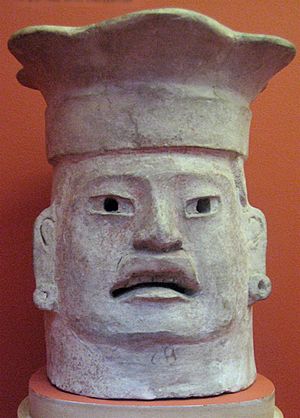
Oaxaca's mountains and valleys meant that different groups of people grew up separately. This led to many different cultures and languages. The central Valley of Oaxaca was very fertile. This allowed powerful groups to grow there. The Zapotec people first lived in the valley. Later, the Mixtecs took over in the 13th century.
These groups lived in villages, often with large family groups. They had kings and religious leaders. They were very good at farming. They grew plants like maize (corn), beans, cacao, tomatoes, chili peppers, and squash. They also raised turkeys. Other foods found in Oaxaca included pineapples, avocados, and maguey. The Pacific Ocean was also a key food source.
Their amazing buildings can still be seen today. Important places include Monte Albán, Mitla, and Guiengola. Monte Albán was a huge religious center built by the Zapotec people. It was most important between 600 and 900 AD. The ancient Zapotec village of Teotitlán del Valle is one of Mexico's oldest settlements.
Trade was very important during the Zapotec time. People traded farm goods, hunted animals, and fished. They also mined silver and gold. These metals were used by skilled workers to make beautiful items. Trade routes went through Oaxaca to the Mayan lands and to Central and South America.
In the mid-1400s, the Aztecs conquered the central valley. They made the Mixtec and Zapotec kingdoms pay taxes to their emperor. The Aztecs built a military base in the valley around 1496. They called it Huāxyacac, which means "place of guaje trees." Later, under Spanish rule, this name became Oaxaca.
Spanish Rule
When the Spanish conquered the Aztec empire in 1521, Oaxaca became part of their new lands. Hernán Cortés, the Spanish conqueror, was given Oaxaca. In 1521, the Spanish started a settlement called Segura de la Frontera. It was later named Nueva Antequera. In 1532, it became a royal city called Antequera de Guaxaca.
The Spanish quickly changed the valley. They brought new foods and farming methods. Cortés ordered wheat to be grown and mills to be built. They also grew sugar cane and brought in silkworms. Sadly, diseases brought by the Spanish greatly reduced the native population. Many Oaxacans were also forced to work in dangerous gold mines.
For 300 years, Spanish ways became common. Important government jobs were held by Spanish people or their descendants. Later, people of mixed European and native background, called mestizos, also held these jobs.
Independence and Revolution
Mexico became independent from Spain in 1821. For many years after, Oaxaca mostly relied on farming. There was not much new industry. When cars became popular, it created a difference between old villages and new cities. A railroad was built, connecting Oaxaca to Mexico City.
The Mexican Revolution started in 1910. Many people in Oaxaca supported Emiliano Zapata. He believed that land should belong to the workers. This idea was popular because many Oaxacans were treated unfairly by big landowners. After the leader Díaz was removed, the revolutionary leaders disagreed. This caused more problems for Mexico. When Venustiano Carranza became president, Oaxaca's relationship with the government got worse. From 1916 to 1920, there was a lot of fighting for control. Federal troops eventually won.
After the revolution, Oaxaca received little help from the national government. This meant there was almost no new industry or economic growth. Oaxaca did not benefit much from Mexico's fast growth after World War II (1939–1945). By the 1980s and 1990s, Oaxaca was one of Mexico's poorest states. It had high rates of people who couldn't read, poor nutrition, and babies dying young. This was especially true for its Native American population.
Modern Challenges
Oaxaca is a great place to grow shade coffee. This coffee grows under existing forest trees. This helps keep the forest healthy and prevents soil from washing away. However, many trees are being cut down to make room for farming. This is because coffee prices dropped a lot.
Cutting down trees is a big problem. It leads to erosion, where soil is washed away. This forces many poor farmers to move to cities or even to the U.S.
Geography and Climate
Oaxaca is located where the Sierra Madre Oriental and Sierra Madre del Sur mountain ranges meet. This makes the land very rugged and mountainous. There is a large, mild central valley. The average height above sea level is about 1,500 meters (5,085 feet).
Oaxaca can experience earthquakes. On February 12, 2008, a 6.4 magnitude earthquake happened there.
People and Culture
Demographics
Oaxaca has many indigenous people. There are 16 officially recognized native communities. Some of these groups have their own unique cultures. Here are the 16 groups and how many people spoke their language in 2005:
|
About 477,788 people speak only their native language, not Spanish. Most of these native languages belong to the Oto-Manguean family. About 85% of the people in Oaxaca are Catholic.
Education
Education in Oaxaca faces challenges because people live in many spread-out communities. The average person goes to school for only 6.4 years, which is just a bit more than primary school.
Some higher education schools in Oaxaca include:
- Instituto Tencológico de Oaxaca (ITO)
- Universidad Autónoma Benito Juárez de Oaxaca (UABJO)
- Universidad de la Sierra Juárez (USJ)
Festivals and Celebrations
Major festivals in Oaxaca include the día de los muertos ("day of the dead") and noche de los rabanos ("night of the radishes"). In Zapotec villages, families often help pay for big dances and feasts for saint's days. They do this by saving money over many years. This system is called guelaguetza.
This practice gave its name to the biggest festival of dance and music in the state, the Guelaguetza. It is a huge event that brings in tourists from all over the world. It happens every year in a stadium overlooking Oaxaca City.
Crafts and Art
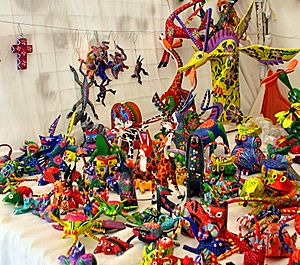
Oaxaca is famous for its traditional crafts. These include making alebrijes, weaving textiles, and creating black clay objects. Alebrijes are colorful wooden statues of mythical creatures, animals, or combinations of both. They are usually painted with bright colors.
Many communities in Oaxaca are known for their crafts. However, many of these crafts were only made recently to attract tourists. The income from crafts often depends on what tourists like. After some difficult times around 2006-2007, the demand for some crafts almost disappeared. For example, some basket makers stopped their craft, and weavers found it hard to sell their goods.
Delicious Cuisine
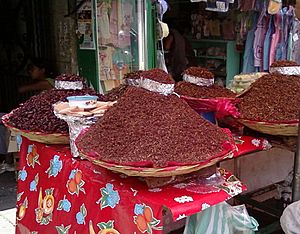
Oaxaca is known as the "Land of the Seven Moles" because it has so many different kinds of food. The central valley grows many fruits and vegetables. Tropical fruits are found in the north, and seafood is popular in the south. Oaxaca is also famous for its Oaxaca cheese (quesillo), which is now sold worldwide.
Corn tortillas are a main food. Many dishes are made from corn dough, like entomatadas, empanadas, tamales, and tlayudas. Black beans are also common. The pasilla chile gives many dishes a smoky, hot taste and red color.
A special breakfast dish, usually only found in Oaxaca, is huevos oaxaqueños. These are eggs cooked in a chili-tomato soup. Another unique dish is chapulines, which are roasted grasshoppers. People eat chapulines after the rainy season starts and into early autumn.
Oaxaca is well-known for making mezcal. This is an alcoholic drink similar to tequila. It is made from the agave plant, but it has a different taste. Oaxaca is also famous for its chocolate. This chocolate is made from ground cacao beans and often includes almonds, cinnamon, and other ingredients.
Industry and Travel
Oaxaca's main industry is tourism. It has over 250 kilometers (155 miles) of beaches, old colonial buildings, ancient ruins, and beautiful crafts. The city of Oaxaca is a popular colonial destination. It has the Santo Domingo Temple, the Government Palace, and museums.
Monte Alban is a very important archaeological site. It was once the capital of the ancient Mixtec-Zapotec empire. Mitla, which means "place of the dead" in Zapotec, is known for its unique ancient tile work.
Farming in Oaxaca mostly focuses on growing the agave plant. This plant is used to make Mezcal, a famous drink linked to Oaxaca. Other important crops include black beans, mangoes, green peppers, lemons, sugar cane, peanuts, melons, corn, and coffee. The fishing industry catches red-snapper and dogfish. The mining industry extracts sulfur.
Transportation
Oaxaca has many roads and highways. A toll-road connects Oaxaca City to Mexico City through Puebla. Another road will connect Oaxaca City to Huatulco. Major airports include Oaxaca City's Xoxocotlán International Airport. There are also smaller airports in Huatulco and Puerto Escondido. These airports are served by several airlines.
Government
The state of Oaxaca is divided into 571 municipalities. This is more than any other Mexican state. Each municipality is led by a municipal president (mayor).
These municipalities are grouped into 8 regions: Cañada, Costa, Istmo, Juchitan, Papaloapan, Sierra Norte, Sierra Sur, and Valles Centrales.
There are so many municipalities because Oaxaca is a large state with rough land. Also, native communities often feel very connected to their village, not just their region.
Many towns and villages govern themselves using a system called Usos y Costumbres. This system helps them keep their culture and traditional ways of doing things. It is believed that this helps protect the land of indigenous people. However, this system can also lead to differences between villages. This can cause rivalries between regions and groups.
Images for kids
-
Cathedral of Our Lady of the Assumption, the main church of the Oaxacan Archdiocese
-
The Central Eólica Sureste I, Fase II in Asunción Ixtaltepec. The Isthmus of Tehuantepec has the most wind energy in Mexico.
-
Ex-monastery of Santiago Apóstol in Cuilapan de Guerrero
See also
 In Spanish: Oaxaca para niños
In Spanish: Oaxaca para niños




